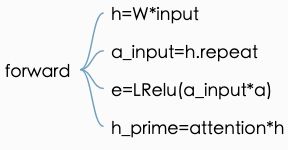Graph Attention Network 图注意力网络 (二) 模型定义
目的:前面详解了GAT(Graph Attention Network)的论文,并且概览了代码,我们需要对于原论文查看模型结构如何定义的。
图注意力网络(GAT) ICLR2018, Graph Attention Network论文详解
Graph Attention Network (一) 训练运行与代码概览
代码地址:https://github.com/Diego999/pyGAT
论文地址:This is a pytorch implementation of the Graph Attention Network (GAT) model presented by Veličković et. al (2017, https://arxiv.org/abs/1710.10903). ICLR 2018
目录
一、模型结构定义
1.1 定义位置
1.2 输入参数
1.3 GAT网络结构
二、图注意力层graph attention layer
2.1 论文中layer公式
2.2 初始化
三、GAT模型
3.1 论文中公式
3.2 前馈运算
一、模型结构定义
1.1 定义位置
train.py之中,调用模型
# Model and optimizer
if args.sparse:
model = SpGAT(nfeat=features.shape[1],
nhid=args.hidden,
nclass=int(labels.max()) + 1,
dropout=args.dropout,
nheads=args.nb_heads,
alpha=args.alpha)
else:
model = GAT(nfeat=features.shape[1],
nhid=args.hidden,
nclass=int(labels.max()) + 1,
dropout=args.dropout,
nheads=args.nb_heads,
alpha=args.alpha)
optimizer = optim.Adam(model.parameters(),
lr=args.lr,
weight_decay=args.weight_decay)1.2 输入参数
model = SpGAT(nfeat=features.shape[1],
nhid=args.hidden,
nclass=int(labels.max()) + 1,
dropout=args.dropout,
nheads=args.nb_heads,
alpha=args.alpha)- nfeat,即输入的特征的个数,但是我们不知道是论文中所讲的F还是F'
- nhid,即隐层单元的个数,默认是8
- nclass,需要输出的分类数,这个肯定为F'
- dropout,dropout的概率,(1 - keep probability),默认为0.6
- nheads,注意力机制之中head的个数,也就是论文中的K
- alpha,LeakeyRelu的小于零的斜率,默认为0.2
1.3 GAT网络结构
模型初始化
class GAT(nn.Module):
def __init__(self, nfeat, nhid, nclass, dropout, alpha, nheads):
"""Dense version of GAT."""
super(GAT, self).__init__()
self.dropout = dropout
self.attentions = [GraphAttentionLayer(nfeat, nhid, dropout=dropout, alpha=alpha, concat=True) for _ in range(nheads)]
for i, attention in enumerate(self.attentions):
self.add_module('attention_{}'.format(i), attention)
self.out_att = GraphAttentionLayer(nhid * nheads, nclass, dropout=dropout, alpha=alpha, concat=False)前馈运算
def forward(self, x, adj):
x = F.dropout(x, self.dropout, training=self.training)
x = torch.cat([att(x, adj) for att in self.attentions], dim=1)
x = F.dropout(x, self.dropout, training=self.training)
x = F.elu(self.out_att(x, adj))
return F.log_softmax(x, dim=1)二、图注意力层graph attention layer
2.1 论文中layer公式
作者通过masked attention将这个注意力机制引入图结构之中,masked attention的含义 :只计算节点 i 的相邻的节点 j
节点 j 为![]() ,其中Ni为 节点i的所有相邻节点。为了使得互相关系数更容易计算和便于比较,我们引入了softmax对所有的i的相邻节点j进行正则化:
,其中Ni为 节点i的所有相邻节点。为了使得互相关系数更容易计算和便于比较,我们引入了softmax对所有的i的相邻节点j进行正则化:![]()
实验之中,注意力机制a是一个单层的前馈神经网络,通过权值向量来确定![]() ,并且加入了 LeakyRelu的非线性激活,这里小于零斜率为0.2。(这里我们回顾下几种Relu函数,relu:小于0就是0,大于零斜率为1;LRelu:小于零斜率固定一个值,大于零斜率为1;PRelu:小于零斜率可变,大于零斜率为1;还有CRelu,Elu,SELU)。注意力机制如下:
,并且加入了 LeakyRelu的非线性激活,这里小于零斜率为0.2。(这里我们回顾下几种Relu函数,relu:小于0就是0,大于零斜率为1;LRelu:小于零斜率固定一个值,大于零斜率为1;PRelu:小于零斜率可变,大于零斜率为1;还有CRelu,Elu,SELU)。注意力机制如下:
![]() ,也是我们前面需要得到的注意力互相关系数
,也是我们前面需要得到的注意力互相关系数![]()
![]()
在模型中应用相互注意机制a(Whi,Whj),通过权重向量 a 参数化,应用 LeakyReLU 激活
- 模型权重为

- 转置表示为T
- concatenation 用 || 表示
- 公式含义就是权值矩阵与F'个特征相乘,然后节点相乘后并列在一起,与权重
 相乘,LRelu激活后指数操作得到softmax的分子
相乘,LRelu激活后指数操作得到softmax的分子
2.2 初始化
初始化时,定义模型中需要的参数W和a,论文中有描述
def __init__(self, in_features, out_features, dropout, alpha, concat=True):
super(GraphAttentionLayer, self).__init__()
self.dropout = dropout
self.in_features = in_features
self.out_features = out_features
self.alpha = alpha
self.concat = concat
self.W = nn.Parameter(torch.zeros(size=(in_features, out_features)))
nn.init.xavier_uniform_(self.W.data, gain=1.414)
self.a = nn.Parameter(torch.zeros(size=(2*out_features, 1)))
nn.init.xavier_uniform_(self.a.data, gain=1.414)
self.leakyrelu = nn.LeakyReLU(self.alpha)三、GAT模型
3.1 论文中公式
在上面的output feature加入计算multi-head的运算公式:
![]()
- concate操作为||
- 第k个注意力机制为

- 共大K个注意力机制需要考虑,小k表示大K中的第k个
- 输入特征的线性变换表示为

- 最终的输出为h' 共由KF' 个特征影响
3.2 前馈运算
def forward(self, input, adj):
h = torch.mm(input, self.W)
N = h.size()[0]
a_input = torch.cat([h.repeat(1, N).view(N * N, -1), h.repeat(N, 1)], dim=1).view(N, -1, 2 * self.out_features)
e = self.leakyrelu(torch.matmul(a_input, self.a).squeeze(2))
zero_vec = -9e15*torch.ones_like(e)
attention = torch.where(adj > 0, e, zero_vec)
attention = F.softmax(attention, dim=1)
attention = F.dropout(attention, self.dropout, training=self.training)
h_prime = torch.matmul(attention, h)
if self.concat:
return F.elu(h_prime)
else:
return h_prime

